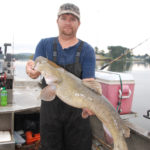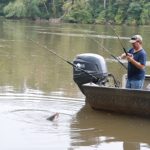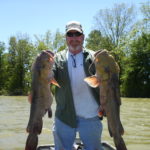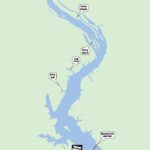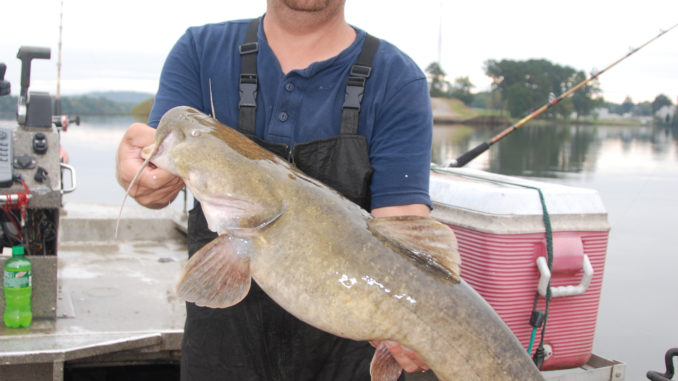
Look for current and cover and you’ll hang into a Blewett Falls flathead
A day of fishing begins early for Robbie Burr of Lilesville. A catfish guide who operates Pee Dee Fishing Adventures, Burr often meets his clients somewhere around daylight, and in order to make that appointment, he typically has to be on the water several hours earlier, launch his boat and catch bait for the day’s fishing, then trailer the boat and drive to pick up his clients.
That seems like a lot of work, but for Burr, his clients and the flathead catfish they’re targeting, nothing but the freshest bait will fit the bill.
After the rendezvous, Burr and company head for one of the prime Piedmont reservoirs known to hold trophy flatheads. Nine times out of 10, that will be Blewett Falls Lake.
“Blewett Falls has a good population of different catfish — blue cats, flatheads and channel cats,” said Burr. “In my years of guiding up here, there are more blue cats than any of them, but the bigger fish we catch up here seem to be flatheads.”
How blues and flatheads got into Blewett Falls, a 2,560-acre reservoir that’s the farthest downstream of any on the Yadkin/Pee Dee River system, is somewhat of a mystery. According to Lawrence Dorsey, a fisheries biologist with the N.C. Wildlife Resources Commission, neither species is native to the system, yet most of the impoundments have populations of both.
“Our best guess was the fish became available in the late 1960s when the state was doing some work with catfish up at the old Fayetteville Hatchery,” Dorsey said. “Instead of disposing of the fish, they were released into tributaries of the Cape Fear River. Flatheads are a highly adaptive species, so they survived where most newly introduced species just wouldn’t make it. Over time, they spread, either by migration or by anglers moving them from one location to the other. Now you’ll find them in most major river systems in the state.”
When it comes to Blewett Falls, flatheads found an environment to their liking and the fish have thrived, both in the impoundment and in the river below the dam, which is operated by Duke Power/Progress Energy.
“(They draw) water out of the lake for electricity every day,” said Burr. “It’s a small lake, and when it gets that current, it fishes just like a river. The current stirs everything up. The fish feed heavy when they’re drawing water out of the lake. On the upper end, when we get big rains like we’ve had this summer, we get a lot of water coming down the river, and the lake will actually flood — then it’s really a river-type system. Those catfish love it either way.”
Dorsey also adds that Blewett Falls’ fertility level, in terms of forage, is in the top 10 percent of North Carolina waterways.
“Flatheads are not discriminate feeders; they just want it live,” he said. “Studies have shown flatheads target bullhead catfish in a new area first, then it’s on to sunfish and shad. Blewett Falls has all that, plus a big population of smallmouth buffalo, a carp-like species that just showed up a few years back. Most of the buffalo would be too big for even the largest flatheads, but I’m sure there’s plenty of juveniles for them to feed on.”
Another essential flathead ingredient that isn’t lacking at Blewett Falls is cover. While some standing timber remains in the upper reaches of the lake, it’s the submerged timber and residual stumps that keeps Burr glued to those spots.
“If you could see the water down about 10 foot, you would see nothing but stumps,” he said. “Like the rivers above and below, logs fall in the lake and wash down to the dam. Then, they hang up in these stumps. From there, the logjam just grows. When we get a big rain, it will actually move them around. You have to relocate the log piles from time to time.”
Burr doesn’t believe in fishing near the logjams; he prefers to place his baits where they are touching the structure. To maintain contact, he frequently repositions his baits.
“Anytime I find a specific piece of structure, that’s what I want to throw at,” he said. “If there is somewhere I can tie off close to it, like the marker buoys down at the dam, I will. If I can’t, I’ll anchor. When I cast my rods out, I scatter out (them) in all directions with live shad on them and let the bait go to the bottom. Because I don’t know exactly where the bait landed, I’ll let it sit for 10 minutes. If nothing bites it, I’ll pick the rod up and drag the bait across the bottom until I feel some structure, and then I’ll let it lay there with the shad swimming right beside the structure. That’s when you’ll get your bite, when that bait is struggling right there at his front door.”
Like any bottom-fishing venture, a real possibility of hanging up exists when fishing so close to heavy structure. To combat this, Burr has designed his own live-bait rig. It incorporates components designed for fighting large fish with a 2-ounce bank sinker to anchor the rig and a 2-inch crappie float above to keep the bait from lying on the bottom. The ingenious part of the rig is how Burr keeps the bait on a short leash.
“The rig I make is constructed using saltwater wire,” he said. “It’s what ocean anglers use to tie their rigs with. The rig works like a 3-way swivel, but is put together using a barrel swivel on either end. Then, I crimp the wire to hold the swivel in place. I string beads on the wire, which allows the shad to move in a 360-degree circle on a 6-inch, heavy leader. It keeps an active live bait from tangling the rig up and then dying. Plus, the beads add a little rattle when the bait struggles. I’ve found this to be a lot more productive than your standard Carolina rig.”
On the other end of the line, Burr’s setup is just as meticulous, from his custom designed boat to the tackle he uses.
“I’ve got rod holders all the way around my custom-built, 20-foot aluminum boat,” he said. “That allows me to throw rods in any direction and really cover a lot of water from one anchored spot. The boat is powered with a jet (drive) motor so I can run upstream through rocks in the river without worrying about tearing my foot off.
“My rod and reels are 7-foot Ugly Stick Tiger rods, paired with Abu Garcia 7000 reels spooled with a 100-pound Power Pro braid. I prefer a medium-action rod with 8/0 Gamakatsu circle hooks. You need a rod with a flexible tip that will allow the hook to turn in the fish’s mouth. As a combination, I believe my setup works really well. The clients who fish with me also like it, not only because we usually catch a lot of fish, but it’s organized and comfortable, too.”
DESTINATION INFORMATION
HOW TO GET THERE — Blewett Falls Lake is southwest of Rockingham and southeast of Albemarle, downstream from Lake Tillery. From the US 74 bridge west of Rockingham, head west a half-mile, then turn right onto SR 1748 (Power Plant Rd.). Go two miles to SR 1745 and turn left, then turn right on SR 1747. Inside of a mile, turn right on SR 1759 to the Pee Dee Access Area.
BEST TACTICS — Target both blue and flathead catfish in areas where fish can take advantage of current. This means targeting structure near the dam or in the upper end of the lake where there’s plenty of current. When anchored, fan-cast live baits such as gizzard shad or sunfish on a weighted live-bait rig. Guide Robbie Burr stresses the importance of placing his baits near structure; he frequently repositions his baits so that they are lying adjacent to bottom structure. Gizzard shad can be caught in eddies around Blewett Falls by using a cast net. Any sunfish used for bait must be caught by hook-and-line and possession limit cannot exceed the daily creel limit for that species.
GUIDES/FISHING INFO — Robbie Burr, Pee Dee Fishing Adventures, 704-695-2587, www.pdfishingadventures.com; Duke Energy Yadkin-Pee Dee River Project, 800-777-9898, www.duke-energy.com/lakes/yadkin-peedee-pigeon-river.asp
ACCOMMODATIONS — Anson County Chamber of Commerce, 704-694-4181, www.ansoncounty.org; Richmond County Chamber of Commerce, 910-895-9058, www.richmondcountychamber.com
MAPS — Delorme North Carolina Atlas & Gazetteer, 800-5611-5105, www.delorme.com; Navionics Electronic Charts, 6 Thatcher Lane, Wareham, MA 02571; Fishing Hot Spots, 800-ALLMAPS, www.fishinghotspots.com

